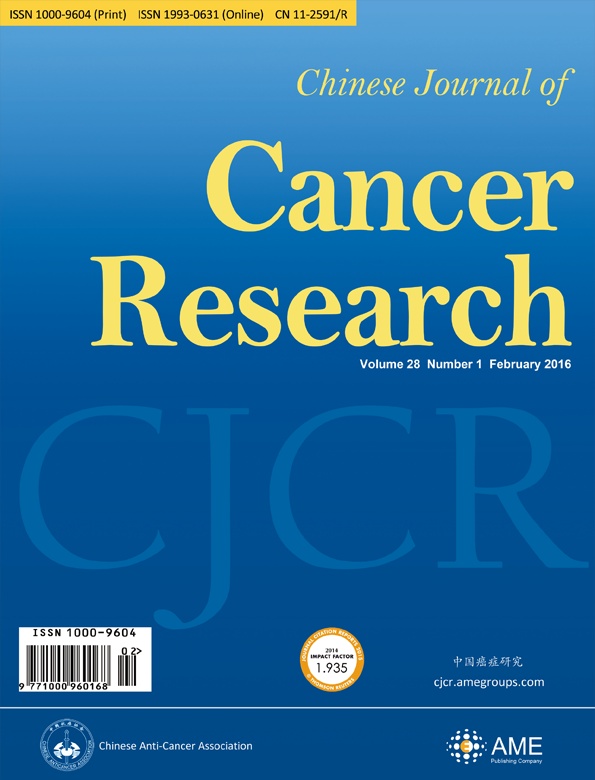FAT1, a direct transcriptional target of E2F1, suppresses cell proliferation, migration and invasion in esophageal squamous cell carcinoma
IF 7
2区 医学
Q1 ONCOLOGY
引用次数: 21
Abstract
Objective Growing evidence indicates that FAT atypical cadherin 1 (FAT1) has aberrant genetic alterations and exhibits potential tumor suppressive function in esophageal squamous cell carcinoma (ESCC). However, the role of FAT1 in ESCC tumorigenesis remains not well elucidated. The aim of this study was to further investigate genetic alterations and biological functions of FAT1, as well as to explore its transcriptional regulation and downstream targets in ESCC. Methods The mutations of FAT1 in ESCC were achieved by analyzing a combined study from seven published genomic data, while the copy number variants of FAT1 were obtained from an analysis of our previous data as well as of The Cancer Genome Atlas (TCGA) and Cancer Cell Line Encyclopedia (CCLE) databases using the cBioPortal. The transcriptional regulation of FAT1 expression was investigated by chromatin immunoprecipitation (ChIP) and the luciferase reporter assays. In-cell western, Western blot and reverse transcription-quantitative polymerase chain reaction (RT-qPCR) were used to assess the indicated gene expression. In addition, colony formation and Transwell migration/invasion assays were employed to test cell proliferation, migration and invasion. Finally, RNA sequencing was used to study the transcriptomes. Results FAT1 was frequently mutated in ESCC and was deleted in multiple cancers. Furthermore, the transcription factor E2F1 occupied the promoter region of FAT1, and depletion of E2F1 led to a decrease in transcription activity and mRNA levels of FAT1. Moreover, we found that knockdown of FAT1 promoted KYSE30 and KYSE150 cell proliferation, migration and invasion; while overexpression of FAT1 inhibited KYSE30 and KYSE410 cell proliferation, migration and invasion. In addition, knockdown of FAT1 led to enrichment of the mitogen-activated protein kinase (MAPK) signaling pathway and cell adhesion process. Conclusions Our data provided evidence for the tumor suppressive function of FAT1 in ESCC cells and elucidated the transcriptional regulation of FAT1 by E2F1, which may facilitate the understanding of molecular mechanisms of the progression of ESCC.FAT1是E2F1的直接转录靶点,在食管鳞状细胞癌中抑制细胞增殖、迁移和侵袭
目的越来越多的证据表明,FAT非典型钙粘蛋白1(FAT1)在食管鳞状细胞癌(ESCC)中具有异常的基因改变和潜在的抑瘤功能。然而,FAT1在ESCC肿瘤发生中的作用尚不清楚。本研究的目的是进一步研究FAT1的遗传改变和生物学功能,并探索其在ESCC中的转录调控和下游靶点。方法通过分析7个已发表的基因组数据的联合研究,获得ESCC中FAT1的突变,而FAT1的拷贝数变异是通过分析我们以前的数据以及使用cBioPortal的癌症基因组图谱(TCGA)和癌症细胞系百科全书(CCLE)数据库获得的。通过染色质免疫沉淀(ChIP)和荧光素酶报告基因分析研究FAT1表达的转录调控。采用细胞内蛋白质印迹、逆转录定量聚合酶链反应(RT-qPCR)等方法对指示基因的表达进行评估。此外,集落形成和Transwell迁移/入侵测定用于测试细胞增殖、迁移和入侵。最后,使用RNA测序来研究转录组。结果FAT1在ESCC中突变频繁,在多种癌症中缺失。此外,转录因子E2F1占据FAT1的启动子区,并且E2F1的缺失导致FAT1的转录活性和mRNA水平降低。此外,我们发现敲低FAT1促进了KYSE30和KYSE150细胞的增殖、迁移和侵袭;而FAT1的过表达抑制了KYSE30和KYSE410细胞的增殖、迁移和侵袭。此外,FAT1的敲除导致丝裂原活化蛋白激酶(MAPK)信号通路和细胞粘附过程的富集。结论我们的数据为FAT1在ESCC细胞中的抑瘤作用提供了证据,并阐明了E2F1对FAT1的转录调控,这可能有助于理解ESCC进展的分子机制。
本文章由计算机程序翻译,如有差异,请以英文原文为准。
求助全文
约1分钟内获得全文
求助全文
来源期刊
自引率
9.80%
发文量
1726
审稿时长
4.5 months
期刊介绍:
Chinese Journal of Cancer Research (CJCR; Print ISSN: 1000-9604; Online ISSN:1993-0631) is published by AME Publishing Company in association with Chinese Anti-Cancer Association.It was launched in March 1995 as a quarterly publication and is now published bi-monthly since February 2013.
CJCR is published bi-monthly in English, and is an international journal devoted to the life sciences and medical sciences. It publishes peer-reviewed original articles of basic investigations and clinical observations, reviews and brief communications providing a forum for the recent experimental and clinical advances in cancer research. This journal is indexed in Science Citation Index Expanded (SCIE), PubMed/PubMed Central (PMC), Scopus, SciSearch, Chemistry Abstracts (CA), the Excerpta Medica/EMBASE, Chinainfo, CNKI, CSCI, etc.

 求助内容:
求助内容: 应助结果提醒方式:
应助结果提醒方式:


